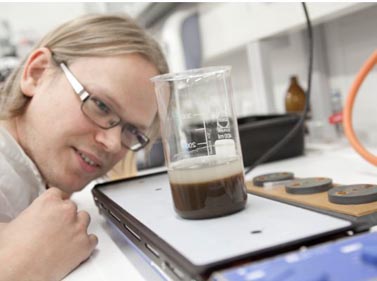Nov 23 2012
Researchers at Aalto University have developed a simple method for reducing the amount of phosphorus in the wastewater of a pulp mill. The method is called simultaneous precipitation using iron sulphate. A separate treatment stage is not required, as the precipitation takes place simultaneously with the actual biological wastewater treatment.
 Background researcher Timo Laukkanen, D.Sc. (Tech.). (Credit: Adolfo Vera)
Background researcher Timo Laukkanen, D.Sc. (Tech.). (Credit: Adolfo Vera)
Iron sulphate is added to the wastewater prior to the biological wastewater treatment process, and the phosphorus dissolved into the water is precipitated with the biomass at the treatment plant. Finally, the phosphorus is removed from the plant with the sludge. In Finland, sludge is generally burned, in which case the phosphorus would end up in the ashes and would thus be reusable in the form of fertilizers, for example.
- At best, the amount of phosphorus in the wastewater was reduced by more than 80 per cent, when the amount of iron fed into the process was 10 milligrams per litre,' commented researcher Sakari Toivakainen, who is currently preparing his doctoral dissertation.
Simultaneous precipitation creates savings in wastewater treatment costs
Public authorities are calling for the lowering of phosphorus emissions. For this reason, many factories have adopted an additional post-treatment precipitation stage, which is usually implemented using aluminium.
- Post-treatment precipitation using aluminium produces difficult-to-process sludge. On the whole, simultaneous precipitation would seem to be a more advantageous option, Timo Laukkanen, Doctor of Science (Technology), concludes.
Simultaneous precipitation does not require additional wastewater treatment units, so there is no need for additional energy in the treatment of the water, either. An additional benefit of the method is that iron sulphate is an inexpensive chemical. A municipal wastewater treatment plant in Saint Petersburg constructed a few years ago employs simultaneous precipitation, among other methods. The industry, on the other hand, is only just waking up to the possibility of applying simultaneous precipitation. Wastewater from the forestry industry contains less phosphorus than municipal wastewater, so the dosage of the iron chemical remains within reasonable limits.
Experiments at the pulp mill
Initially, the research was carried out in the laboratories of Otaniemi and at the plant using pilot equipment. The results were so promising that, later on; iron precipitation was also successfully tested at the wastewater treatment section of a pulp mill.
- From the viewpoint of comprehensive environmental protection and sustainable development, the best method is always the one that saves energy and minimises the amount of waste. With the help of the studied simultaneous precipitation method, it is possible to completely avoid additional stages of wastewater treatment, reduce the amount of solid waste and save energy. Simultaneous precipitation produces hundreds of thousands of euros worth of savings in operating costs, as energy consumption and the need for additional chemicals is reduced, Professor Olli Dahl crystallises.
The research has been published in the Water Science & Technology journal.